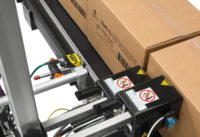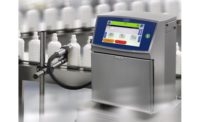Supplier Close Up: Leibinger
Eliminating inkjet coder downtime
Months of productivity without maintenance are possible with LEIBINGER technology.

Packaging Strategies: Your tagline is “the way inkjet was meant to work.” What does that mean?
Jan Visser, vice president & general manager- Americas: Continuous Inkjet (CIJ) printers for product coding typically come with common issues: They are very difficult to keep running, they require very frequent maintenance and very regular cleaning. The maintenance shop is filled with units that need work – or spares that can be rotated on the line.
LEIBINGER inkjet technology, on the other end, is different by design. It runs clean and doesn’t need the extensive and regular maintenance other brands do. Months of production without cleaning the print head are no exception.
We just don’t believe the typical inkjet issues are necessary. That’s why we refer to our technology as the way inkjet was meant to work.
PS: What is the reason for the inkjet issues you’re describing above?
Visser: Are you ready for a quick CIJ lesson? The problem is related to the inherit design of these printers. In CIJ technology, a pressurized stream of ink drops makes its way from the hydraulic system through the umbilical to the print head. Inside the print head, select ink drops are charged and leave the nozzle to form a code on the product. Uncharged drops end up in a gutter and make their way back to the ink circuit. This process is continuous – hence the name.
As soon as the printer is not running, the ink stream stops flowing and the ink inside the print head is exposed to air. Small ink drops dry inside a miniscule print head nozzles and clog the system. This stops the printer from operating correctly and requires cleaning.
Then, when the printer starts up and the ink stream is pressurized again, a sudden burst of ink enters the head – and sprays ink particles on the sensitive charging components. Compare this to putting your thumb on a garden hose and turning on the faucet. You’ll feel the pressure building and as soon as you remove your thumb, water sprays out. This works the same way with ink inside the print head.
Ink that sprays on the charging and other sensitive components messes with the ability to charge the ink drops correctly and consistently. This creates poor readability and reliability – which, again, can only be fixed by cleaning the head.
This is why, in many cases, maintenance staff clean print heads weekly, daily – sometimes even at the beginning or end of every shift. You can fix it temporarily but the problem never goes away.
PS: How does LEIBINGER resolve these issues?
Visser: LEIBINGER is different by design. For one, when the coder doesn’t print, our gutter retracts and hermetically seals the nozzle. Because ink is no longer exposed to air, the ink does not dry and clogged nozzles are prevented.
In addition, when our nozzle is sealed, we maintain a fully pressurized ink stream inside our printer. Simply put, the ink stream is always flowing even when the printer is switched off. When we start back up, there’s no need to pressurize the ink stream and there’s no “garden hose effect.”
We’ve redefined reliability in inkjet printers. We start clean, we run clean – and stay clean. That means productivity and uptime for our customers.
PS: Is this technology proven in the market?
Visser: Absolutely. Some of the biggest names you see at every grocery store have selected LEIBINGER for product coding because of the reliability and uptime. We recently trialed our equipment at a leading manufacturer of canned products and coded 40 million products without a single head cleaning. They couldn’t believe their eyes at first. Since then, the improved productivity has helped them cost justify a replacement of hundreds of competitive units.
For more information about LEIBINGER Inkjet, visit http://leibinger-group.com or email info@LEIBINGERusa.com.
Looking for a reprint of this article?
From high-res PDFs to custom plaques, order your copy today!






